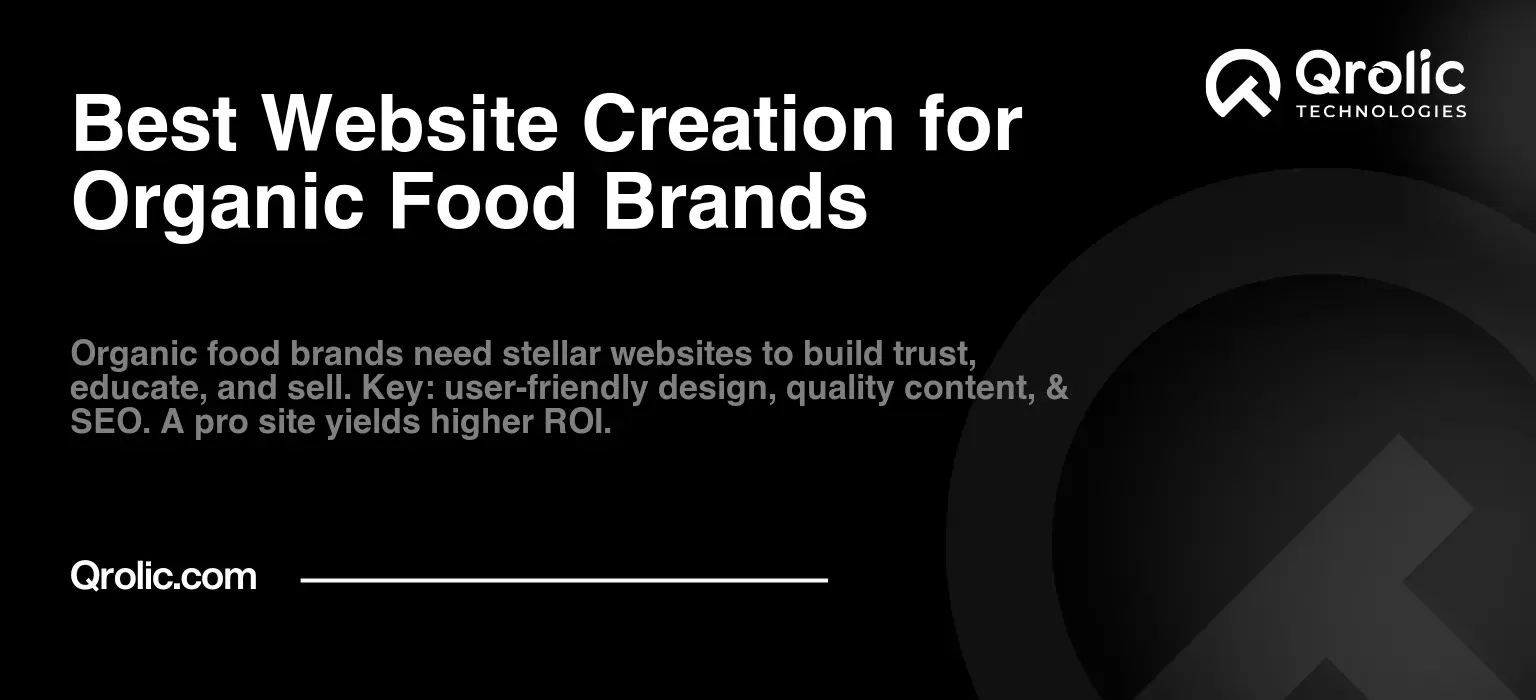Quick Summary:
- A strong website is crucial for organic food brands.
- Focus on user-friendly design, content, and SEO.
- Build trust by sharing your brand story and values.
- Consider professional help for best website results.
Table of Contents
- Why a Stellar Website is Crucial for Organic Food Brands
- The Consequences of a Poor Website
- Key Elements of a Successful Website for Organic Food Brands
- 1. User-Friendly Design & Navigation
- 2. High-Quality Content that Converts
- 3. E-Commerce Functionality (If Selling Online)
- 4. Search Engine Optimization (SEO)
- 5. Building Community and Engagement
- 6. Data Analysis and Improvement
- Step-by-Step Guide to Website Creation for Organic Food Brands
- The Benefits of a Professional Website Creation for Your Organic Food Brand
- Qrolic Technologies: Your Partner in Website Creation for Organic Food Brands
- Conclusion: The Path to Online Success for Organic Food Brands
Why a Stellar Website is Crucial for Organic Food Brands
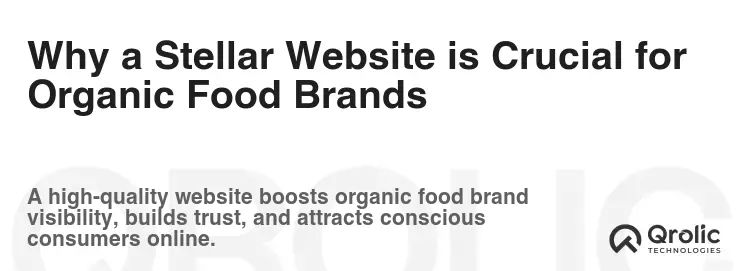
In today’s digital-first world, a website isn’t just an optional extra for an organic food brand – it’s the cornerstone of your business. It’s your virtual storefront, your storyteller, and your primary engagement hub. For consumers increasingly conscious about what they consume and where it comes from, a compelling, informative, and trustworthy website is non-negotiable.
Beyond a Simple Online Presence:
A well-crafted website isn’t merely about listing products; it’s about creating an immersive brand experience. It’s about:
- Building Trust and Transparency: Organic food shoppers are discerning. They want to know your story – where your ingredients are sourced, your farming practices, and your commitment to sustainability. Your website is the ideal platform to communicate this transparency.
- Educating Your Audience: Many consumers are still learning about the benefits of organic food. Your website can serve as an educational resource, highlighting the health benefits, the environmental impact, and the ethical considerations associated with choosing organic.
- Connecting with Customers: A website allows you to build a direct relationship with your customers. Through contact forms, email subscriptions, and social media integration, you can foster a community around your brand.
- Boosting Sales and Revenue: Ultimately, a website is a powerful sales tool. An e-commerce enabled site can drastically expand your reach, allowing you to sell your products directly to consumers nationwide (or even globally).
- Establishing Authority: A website demonstrates that you are a legitimate business, and that you are serious about providing quality organic products. It helps you stand out in a competitive market.
The Consequences of a Poor Website
On the flip side, a poorly designed or neglected website can severely damage your organic food brand. This could lead to:
- Loss of Credibility: A clunky, outdated website can make consumers doubt the quality of your products.
- Missed Sales Opportunities: If your website is difficult to navigate or doesn’t offer a seamless online shopping experience, potential customers will likely go elsewhere.
- Negative Brand Perception: A poorly designed website can give the impression that your brand is unprofessional or unreliable.
- Reduced Visibility: A website that is not optimized for search engines (SEO) will struggle to attract organic traffic.
Key Elements of a Successful Website for Organic Food Brands
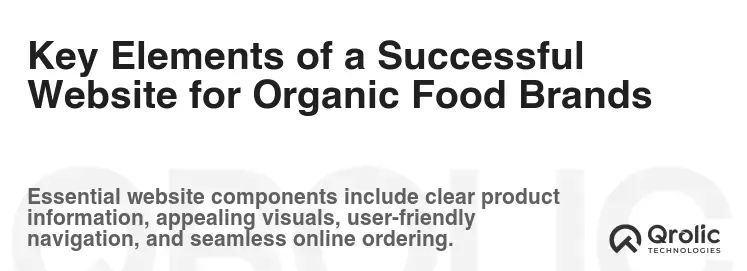
Creating a successful website for your organic food brand isn’t just about aesthetics. It requires a strategic approach that considers your target audience and business goals. Here are the core elements to focus on:
1. User-Friendly Design & Navigation
- Intuitive Navigation: Your website should be easy to navigate. Users should be able to quickly find what they are looking for, whether it’s product information, recipes, or your brand story. Use clear and concise menus and submenus.
- Clear Hierarchy: Organize your content logically. Utilize breadcrumbs to show users where they are on the site.
- Mobile-First Approach: With a majority of online browsing happening on mobile devices, your website needs to be responsive and optimized for all screen sizes.
- Visually Appealing Layout: Use high-quality images and videos that showcase your products beautifully. A clean, modern design with plenty of white space will enhance the user experience.
- Consistent Branding: Your website should reflect your brand identity with consistent use of colors, fonts, and imagery. This helps create a cohesive and memorable experience.
- Accessibility: Ensure your website is accessible to all users, including those with disabilities. This includes proper use of alt text on images, clear headings, and sufficient color contrast.
- Fast Loading Speeds: No one likes a slow website. Optimize your images and code to ensure pages load quickly.
2. High-Quality Content that Converts
- Compelling Brand Story: Tell your brand’s story. Share your passion for organic food, your farming practices, and your commitment to sustainability. Connect with your audience on an emotional level.
- Authenticity: Be authentic and transparent in your storytelling. Show the “real” people behind your brand.
- Customer Testimonials: Include positive reviews and testimonials from satisfied customers to build social proof.
- Detailed Product Information: Provide complete and accurate information about each product. Include:
- Ingredients Lists: Be transparent about all ingredients, highlighting their organic certification.
- Nutritional Information: Clearly display nutritional facts and health benefits.
- Origin Information: Explain where your ingredients are sourced from.
- High-Quality Product Photos: Use professional photos from multiple angles.
- Educational Blog: Create a blog that shares informative content related to organic food, health, and wellness.
- Recipe Ideas: Publish recipes that showcase your products and inspire customers to use them creatively.
- Health Benefits: Highlight the health benefits of consuming organic foods.
- Industry Insights: Share updates about organic farming practices and industry trends.
- Call to Action: Include clear and compelling calls to action throughout your website. Examples: “Shop Now,” “Learn More,” “Subscribe to Our Newsletter”.
3. E-Commerce Functionality (If Selling Online)
- Secure Payment Gateway: Integrate a secure and reliable payment gateway to ensure your customers’ financial information is protected.
- Easy Checkout Process: Make the checkout process as simple and straightforward as possible, with minimal steps.
- Flexible Shipping Options: Offer a variety of shipping options to cater to different needs and budgets.
- Order Tracking: Allow customers to track their orders easily.
- Customer Accounts: Enable customers to create accounts, store shipping information, and view order history.
4. Search Engine Optimization (SEO)
- Keyword Research: Identify the keywords that your target audience is using to search for organic food products. Use these keywords strategically throughout your website content, including page titles, meta descriptions, headings, and image alt text.
- Long-tail Keywords: Target specific long-tail keywords that have lower competition and are more likely to attract qualified traffic. For example, instead of just targeting “organic food,” target phrases like “best organic baby food” or “locally sourced organic vegetables”.
- On-Page Optimization: Optimize all of your website pages for search engines. Ensure each page has a unique title tag and meta description, use header tags (H1, H2, H3) to structure your content, and optimize your images for search.
- Mobile-Friendliness: Ensure your website is mobile-friendly since Google prioritizes mobile-first indexing.
- Site Speed: Optimize your website to load quickly.
- Off-Page Optimization: Build high-quality backlinks to your website from other reputable websites. Focus on quality over quantity.
- Local SEO: If you have a physical store or deliver locally, optimize for local search by claiming your Google My Business listing and building local citations.
- Content Marketing: Regularly publish fresh, high-quality content that is relevant to your target audience. This helps attract organic traffic and keeps your website fresh.
- Blog Optimization: Optimize your blog posts for relevant keywords.
5. Building Community and Engagement
- Email Marketing: Build an email list and use it to connect with your customers, share updates, and promote special offers.
- Personalized Content: Segment your email list and personalize your messaging based on customer interests and behaviors.
- Welcome Email: Create an engaging welcome email for new subscribers.
- Social Media Integration: Integrate your social media profiles into your website, making it easy for visitors to follow you and share your content.
- Consistent Posting: Post engaging content regularly on social media, and use it to drive traffic to your website.
- Contact Us Page: Make it easy for customers to contact you with questions or concerns. Include a contact form, email address, and phone number.
- Customer Reviews and Feedback: Encourage customers to leave reviews and provide feedback on your products and services.
6. Data Analysis and Improvement
- Track Your Website Analytics: Use tools like Google Analytics to track key metrics such as website traffic, bounce rate, time on page, and conversion rates.
- Identify Areas for Improvement: Analyze your website data to identify areas that need improvement.
- A/B Testing: Experiment with different website elements (e.g., headlines, buttons, images) to see what performs best.
- Regular Updates: Keep your website updated with fresh content and new features. Technology and consumer preferences are constantly changing, so your website should be too.
Step-by-Step Guide to Website Creation for Organic Food Brands
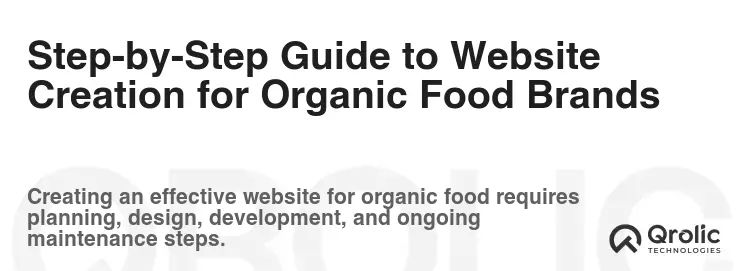
Here’s a practical guide to creating a successful website for your organic food brand:
Step 1: Planning and Research
- Define Your Target Audience: Who are you trying to reach with your organic food products? Understand their demographics, interests, and buying habits.
- Set Clear Goals: What do you want to achieve with your website? Do you want to increase brand awareness, generate leads, or sell products online?
- Competitor Analysis: Research your competitors’ websites. Identify their strengths and weaknesses, and look for opportunities to differentiate yourself.
- Keyword Research: Conduct keyword research using tools like Google Keyword Planner, SEMrush, or Ahrefs to find the keywords your target audience is using.
- Choose a Domain Name: Select a domain name that reflects your brand and is easy to remember.
Step 2: Choose a Website Platform
- Content Management System (CMS): Select a CMS platform that suits your needs and technical abilities.
- wordpress: This is the most popular CMS and offers a high level of flexibility and customization. Great for blogs and e-commerce stores.
- Shopify: A user-friendly e-commerce platform ideal for selling products online.
- Squarespace: An easy-to-use website builder with beautiful templates, perfect for those less familiar with web design.
- Consider Your Needs: Factor in your technical capabilities, budget, and desired functionality.
Step 3: Design and Development
- Choose a Theme/Template: Select a theme or template that aligns with your brand identity and is user-friendly.
- Customize Your Website: Customize the theme or template to reflect your brand’s colors, fonts, and imagery.
- Create Essential Pages: Create essential pages, including:
- Home page
- About Us page
- Products page
- Blog
- Contact Us
- Privacy Policy
- Terms and Conditions
- Develop Your Content: Create high-quality, SEO-optimized content for each page. Use compelling language and strong calls to action.
Step 4: E-Commerce Integration (If Applicable)
- Set up an online store: Integrate an e-commerce platform or plugin to enable online sales.
- Add your products: Include detailed product information, high-quality images, and secure payment options.
- Configure shipping settings: Set up your shipping options and calculate rates.
Step 5: Optimize for SEO
- Implement your keyword strategy: Incorporate your target keywords into your website content.
- Optimize meta descriptions and title tags: Write compelling and keyword-rich meta descriptions and title tags for each page.
- Optimize images: Use descriptive alt text for your images.
- Build backlinks: Focus on acquiring high-quality backlinks from reputable websites.
- Improve site speed: Ensure your website loads quickly for a smooth user experience.
Step 6: Testing and Launch
- Test your website on various devices: Ensure your website is mobile-friendly and functions well on all devices.
- Test your payment gateway: Verify that your payment gateway is working properly.
- Get user feedback: Ask a group of trusted friends or family members to test your website and provide feedback.
- Launch your website: Once you are confident that everything is working correctly, officially launch your website.
Step 7: Ongoing Maintenance and Optimization
- Monitor your website analytics: Track key metrics such as traffic, engagement, and conversions.
- Make ongoing improvements: Use data analysis to identify areas for improvement and make necessary adjustments.
- Keep your content fresh: Publish new content regularly to keep your website engaging.
The Benefits of a Professional Website Creation for Your Organic Food Brand
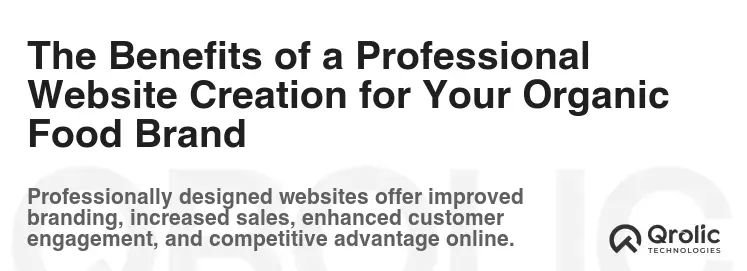
While DIY website builders might seem tempting for cost-saving purposes, the value of hiring a professional Web Development team, especially those experienced in organic food brands, cannot be overstated. Here’s why:
- Expertise in Design and Functionality: Professionals have the skills and experience to create a visually appealing website that aligns with your brand identity, is user-friendly, and optimized for conversions.
- SEO Expertise: A professional team will implement best practices in SEO to ensure your website is easily discoverable by search engines, attracting qualified traffic.
- Customization and Scalability: Professionals can create a customized website that meets your specific needs and scales with your business growth, going beyond the limitations of basic templates.
- Faster Turnaround Time: Professionals can often complete projects more quickly than you could on your own, allowing you to launch your website sooner.
- Technical Support and Maintenance: Professionals will provide ongoing technical support and maintenance, ensuring your website continues to function smoothly.
- Focus on Core Business: Delegating your website development to professionals allows you to focus on your core competencies – running your organic food brand.
- Increased ROI: A professional website that is well designed and optimized for conversions will likely deliver a higher return on your investment.
- Better User Experience: An expert can deliver a seamless and enjoyable user experience to your customers.
Qrolic Technologies: Your Partner in Website Creation for Organic Food Brands
At Qrolic Technologies, we understand the unique needs of organic food brands. We have a proven track record of creating beautiful, functional, and high-performing websites that help brands like yours succeed. We specialize in:
- Customized Website Design: We create unique and visually appealing websites that reflect your brand identity and attract your target audience.
- E-commerce Solutions: We integrate secure and reliable e-commerce platforms, making it easy for you to sell your products online.
- SEO Optimization: We implement cutting-edge SEO strategies to improve your search engine rankings and drive organic traffic to your website.
- Content Creation: Our team of experienced writers can create compelling and informative content that resonates with your audience and educates them about your products.
- Mobile-First Design: We ensure your website is fully responsive and optimized for all devices.
- Ongoing Support: We provide ongoing support and maintenance to keep your website running smoothly.
We understand that organic food brands are more than just a business; they represent a commitment to health, sustainability, and ethical practices. We can help you share your story and connect with your customers on a deeper level through your website.
Ready to take your organic food brand to the next level? Contact Qrolic Technologies today for a free consultation. Visit us at https://qrolic.com/ to learn more about how we can help you.
Conclusion: The Path to Online Success for Organic Food Brands
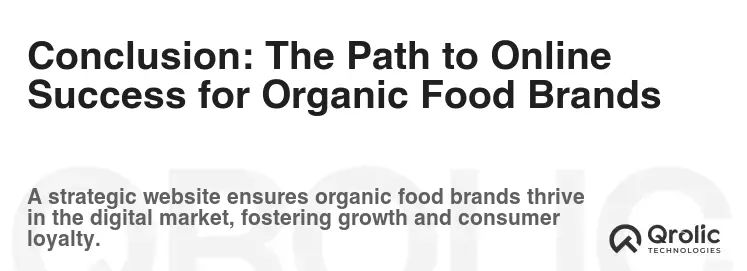
Creating a successful website for your organic food brand requires a well-planned strategy, a clear understanding of your target audience, and a commitment to quality. Your website is not just a digital platform; it is your brand’s virtual ambassador. It’s a chance to tell your unique story, build trust with your customers, and showcase the passion behind your organic products.
By following the guidelines outlined in this article and considering professional web development services like Qrolic Technologies, you can create a website that not only drives sales but also establishes your brand as a leader in the organic food space. Don’t just create a website; create an experience that will resonate with your customers and propel your organic food brand to new heights of success.
